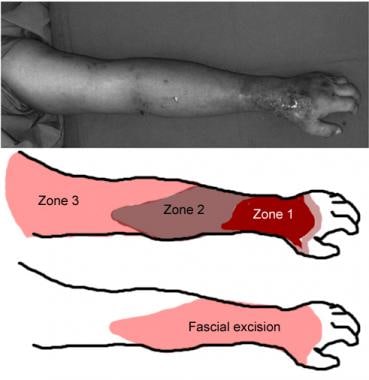Infections, particularly severe ones, can escalate rapidly if not treated properly. What may begin as a seemingly small and harmless injury can turn into a life-threatening condition within hours. The story of one individual, whose hand became severely swollen and discolored after a small injury, serves as a chilling reminder of how quickly infections can spread, potentially leading to significant harm. It’s a stark warning: never ignore early signs of infection, especially if they involve swelling, intense pain, or unusual discoloration.

The urgency of recognizing and responding to these early signs cannot be overstated. Many people tend to dismiss minor injuries or bites, believing that they will heal on their own. However, neglecting the signs of a growing infection could result in irreversible damage. By raising awareness about these early symptoms and encouraging swift medical intervention, we can help prevent serious consequences.
The Mysterious Case of a Rapidly Spreading Infection

What seemed like an innocent injury took a frightening turn when a person’s hand began to swell and blacken dramatically within a short period. This was no ordinary infection. As the area grew increasingly painful and discolored, the individual rushed to seek medical attention, but the infection had already taken a severe toll.
Doctors initially suspected a spider bite or an insect sting, which is known to cause infections in some cases. However, as the condition worsened, they began to suspect something more serious: necrotizing fasciitis, a condition commonly known as flesh-eating bacteria. Necrotizing fasciitis is a rare but dangerous infection that spreads quickly, destroying tissue and requiring urgent medical intervention.
The individual’s hand was severely swollen, darkened, and exhibiting signs of advanced tissue damage. It became clear that necrotizing fasciitis was likely the cause, making it essential to get medical help without delay.
What Is Necrotizing Fasciitis? Understanding the Condition

Necrotizing fasciitis is a severe and potentially deadly bacterial infection that spreads rapidly through the fascia, the connective tissue that surrounds muscles, nerves, and blood vessels. The infection is most often caused by group A Streptococcus (GAS) bacteria, though other types of bacteria can also be involved. In some cases, the infection can be caused by a combination of bacteria.
The condition is rare but highly dangerous. It progresses extremely fast, and if left untreated, it can lead to severe tissue damage, organ failure, and even death. The bacteria release toxins that destroy tissue, causing the affected area to become necrotic (dead tissue). Early signs of necrotizing fasciitis include:
1. Redness and Swelling
The initial symptoms often involve redness, swelling, and warmth around the infected area. If you notice rapid or unusual swelling following a wound, sting, or bite, it may be a sign of infection that requires immediate attention.
2. Severe Pain
Unlike typical pain associated with minor injuries, necrotizing fasciitis often causes intense pain that worsens rapidly. The pain may feel disproportionate to the appearance of the wound, and it can be an indication that the infection is spreading deeper into the tissue.
3. Discoloration and Blackening
One of the most alarming signs of necrotizing fasciitis is discoloration of the skin, often turning a dark purple, blue, or black. The tissue around the infected area may become gangrenous and lose its normal color, signaling that the tissue is dying.
4. Fever and Chills
A fever is a common sign of an infection, and in the case of necrotizing fasciitis, the fever may be accompanied by chills and sweating. This indicates that the infection is causing the body to fight back against the bacteria, but the severity of the condition requires immediate medical care.
Why Quick Action Is Crucial

Necrotizing fasciitis is an infection that moves fast. Within hours, it can spread from the skin to deeper tissues and organs. The bacteria can release toxins that damage tissue, and without rapid medical intervention, the infection can become life-threatening. The best chance for survival is early diagnosis and immediate treatment, which may include:
-
Intravenous Antibiotics: To fight the infection.
-
Surgical Debridement: In many cases, doctors will need to remove necrotic tissue to stop the infection from spreading.
-
Supportive Care: In severe cases, patients may require intensive care to support vital functions.
The faster the intervention, the better the chance of limb preservation and survival. Delayed treatment can result in irreversible tissue loss, septic shock, and even death.
Early Warning Signs: What to Watch For

Recognizing the early signs of a serious infection like necrotizing fasciitis can mean the difference between life and death. Here are some critical early warning signs to watch out for:
1. Wound Infections That Don’t Heal
If a wound becomes red, swollen, and increasingly painful, especially after an injury, bite, or sting, it could be an indication of an infection. The body’s immune system should start healing minor wounds in a few days, so if there is persistent swelling, pain, or heat around the area, seek medical attention immediately.
2. Pain That Doesn’t Match the Injury
One of the hallmark symptoms of necrotizing fasciitis is pain that is disproportionate to the visible injury. If the pain feels much worse than it should for a minor injury, it could be a sign that something more serious is developing beneath the skin.
3. Rapidly Spreading Redness and Swelling
An infection that spreads quickly across the skin, especially if it’s accompanied by fever, is a red flag. If the infection moves past the initial injury site, it could be a sign that the bacteria are spreading deeper into the tissue.
4. Severe Discoloration or Blackening of the Skin
As the infection progresses, the affected skin may turn a dark purple, blue, or black color. This discoloration indicates that the tissue is dying due to the rapid spread of bacteria. Severe discoloration is a critical sign that you should seek medical attention immediately.
The Importance of Seeking Immediate Medical Attention

If you notice any of the above warning signs, it’s crucial to seek immediate medical care. Necrotizing fasciitis is a medical emergency, and quick action is necessary to prevent severe tissue damage or worse. Doctors will often begin treatment right away with antibiotics and may need to perform surgery to remove infected tissue.
In some cases, patients may require additional treatments such as hyperbaric oxygen therapy, which can help fight the infection by delivering higher levels of oxygen to the body.
Don’t Wait: Seek Help Immediately
If you’re in doubt about the severity of an infection, it’s always better to be cautious. Early diagnosis and treatment can save lives. Don’t wait for the infection to spread or worsen before seeking help.
Conclusion: The Importance of Timely Intervention
Infections like necrotizing fasciitis can develop quickly and turn fatal without proper treatment. Recognizing the early signs—such as swelling, intense pain, discoloration, and fever—can help you respond in time to prevent serious complications. If you suspect you have an infection that could be as serious as necrotizing fasciitis, don’t wait. Seek immediate medical attention to ensure that you receive the best possible care.
By acting quickly and ensuring that you receive the necessary treatments, you can improve your chances of recovery and reduce the risk of permanent damage.
